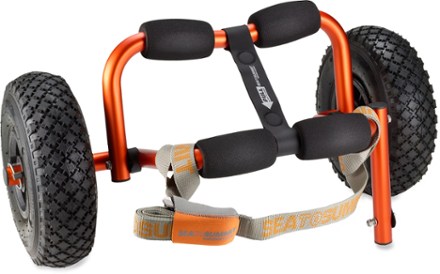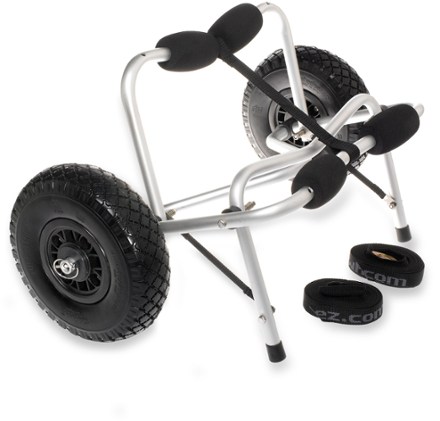Let's talk wheels.
With the acquisition of a quality boat and kayak and the slow but sure amassing of camping gear, the last major expense where reliability is critical is my cart.
But why wheels, Rosser? you ask, bemused. Aren't you taking a water trip? Water-ver will you use wheels for? I'll tell you why wheels, you punny scamp, I say, while sitting back in my canvas-backed lounge chair and proffering a plate of cranberry almond scones as you sit on my rag rug. I probably tousle your hair, too, but only if we agreed in advance that you're okay with that sort of thing.
There are about 62 miles of portaging--or carrying your vessel out of water--over the official route of the NFCT. And that's when the rivers are at peak water level: as I've mentioned before, I'm probably going to do lots more at this stage of the summer. Carrying canoes over portages is easy, since built-in yokes are designed for the job and have done it reliably for hundreds of years. Kayaks are another beast. Carrying them is possible, especially if you rig up a
clever handmade yoke or
packframe attachment, but so many of the portage trails around the NFCT are wheelable that it doesn't make sense not to save your back, grin and bear the extra ~10 pounds, and take a cart.
What's more, if something were to go down such that a hasty retreat back to civilization was called for, the route to that civilization would invariably be paved roads. When the other option is abandoning your bright plastic boat in the brush, you'll wish you had wheels along.
So, I begin my research. The two most promising options from REI are actually not bad:
Sea to Summit Kayak Cart. About 8 pounds, folds down nice and small, but has air-filled wheels, which have a potential to leak. On sale for about $90 on REI's website
Wheeleez Tuff Tire Kayak Cart. Despite the corny name, actually quite appropriate. Sells new for about $135, although I also have a dubious Craigslist lead... Doesn't fold down quite as compactly, but has foam-filled tires, which won't deflate if punctured. Lightest-weight frame of the lot.
There's also the
Seattle Sports Nemo Extremo Center Cart that some folks have had success with. It looks super-rugged, also has foam-filled tires, and sells for $140, although not through REI. 7.5 lbs. The more I look at this cart, though, the more dubious I am about those wheels. It looks as though the wheels are bolted directly onto the cart, relying on those plastic bushings to bear the shear stress. The other frames, you'll notice, have a bar going through the wheel hubs, distributing the weight more easily and being WAY nicer to the bearings. After hearing stories about plastic bearings doing a meltdown, I think I'll pass. Shame, though: this guy definitely folds up the most compactly...
I wouldn't usually quibble over gear like this, but the NFCT features lots of horror stories about carts that are chewed up and spit out by the terrain. NFCT Legend Mack Truax swears by steel frames, but can afford that weight with his light setup. Joe Peterlin, on the other hand, had
a catastrophic failure with a Mighty Mite end cart, after which he vowed to build his own from scratch.
Moral of the story, as long as I spring for something with a reasonably sturdy frame and wide wheels, I'll be golden. Bonus points if I don't have to worry about air leaking out of my tires.
More shopping details as they pan out!







